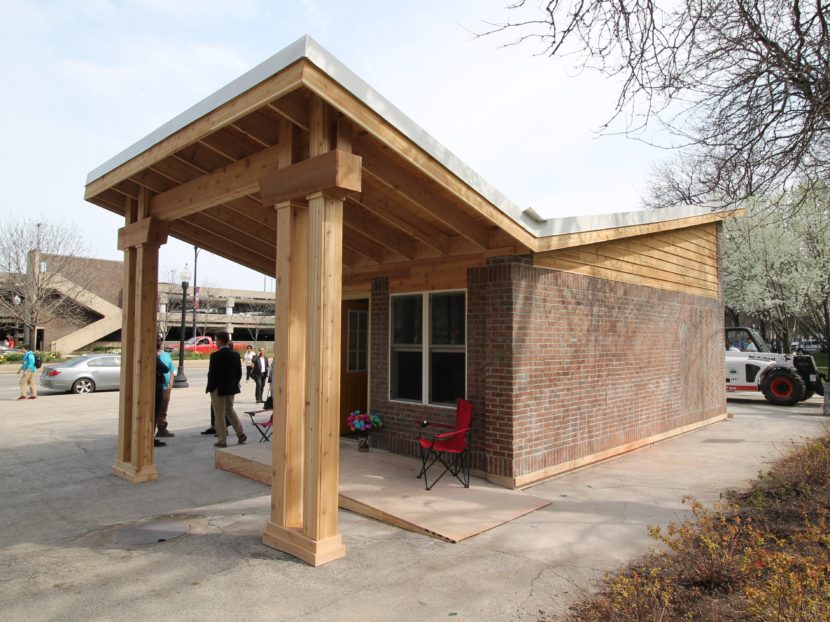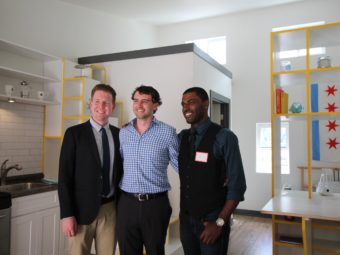
Courtesy of Marty Sandberg
Tiny homes, which can be as little as 50 to 300 square feet, are growing in popularity as a solution for the homeless. In Chicago, advocates want to build tiny houses to serve a specific marginalized group — homeless youth, especially those who identify as LGBTQ.
“Most of the cities in the country that have already implemented housing tiny homes for the homeless are doing it for the chronically homeless or veterans, so no one yet is doing it specifically for the youth target population,” says activist Tracy Baim, who spearheaded a Chicago Tiny Home Summit April 18-19 at the University of Illinois at Chicago.
Baim says tiny homes could provide freestanding independent housing instead of what is typically available for young adults seeking shelter.
“They’re living in group homes, where shared showers, where violence and sexual assaults can happen,” she says. “Your stuff is stolen constantly.”
The summit, which aimed to discuss the practicalities and experiences of building tiny houses, displayed the tiny home design that won the American Institute of Architects’ competition to build a tiny house community for Chicago.

Courtesy of Marty Sandberg
“You actually enter through a breezeway, kind of a covered porch area that’s 8 feet deep,” says Lon Stousland, part of the three-member team that won the competition. Their prototype is fairly big by tiny home standards.
A brick facade surrounds the bright yellow front door. Inside, there’s a twin bed, a bathroom and a combined kitchen and living room area.
“This is closer to 300 square feet,” says architect Terry Howell, another team member. The third team member, Marty Sandberg, says there is another way the structure is different from other tiny houses
“We designed this to actually be one of a series of row homes,” Sandberg says.
Lala Thomas, William Okamura and Maria Cwiklik are three 20-year-olds who were formerly homeless. Now, they live in a transitional housing shelter, and all go to school. They were part of a group chosen to offer design suggestions about what a Chicago tiny home should look like. Thomas was a little surprised by the size.
“Well, I really didn’t like it, I’m going to be honest, because … you really can’t put that much stuff in that little house,” Thomas says. “I mean, I just think it was just … it would be bigger than that.”
Okamura likes the idea.
“By having those walls up, I’d feel 100 times safer than being outside with nothing,” Okamura says.
Cwiklik says even though planning may be in an early stage, she’s optimistic about a tiny home village for youth in Chicago.
“As long as we get more support and as long as we get more youth involved in this program,” Cwiklik says, “it’s going to happen.”
Tiny Homes Might Need To Be A Guerrilla Building Movement
But there are obstacles. Zoning Attorney Danielle Meltzer Cassel says in addition to building codes and zoning ordinances, there is the “not in my backyard” or so-called NIMBY opposition from residents. She says advocates in Chicago must face a dose of reality.
“If this is pitched as something that is for the folks who are the most needy in our society, the door’s going to slam shut,” she says.
In Seattle, activists involved in the tiny home movement have been doing more building and less planning. Melinda Nichols, with the Low Income Housing Institute in the city, says so far volunteers have built 50 to 60 temporary tiny homes under 120 square feet.
“Because people are standing out in the rain waiting for a place to live,” Nichols says. “It’s a crisis, and the way to respond to those things is to do something right now.”
In Nashville, the Rev. Jeff Obafemi Carr with Infinity Fellowship says advocates have to be inventive as they try to provide needed housing. His group raised money to build six tiny homes on wheels without seeking permission.
“Cities and municipalities don’t know what to do with it. The code and zoning laws are antiquated. So there’s going to take a mix of guerrilla tiny home building and planned development,” Carr says.
In Chicago, Baim says the next step for advocates is to create a privately funded tiny home village pilot.
She says that will show developers, city government and Chicago residents how tiny houses could play a huge role in making it safer for young people with no place to call home.
9(MDEwMjQ0ODM1MDEzNDk4MTEzNjU3NTRhYg004))